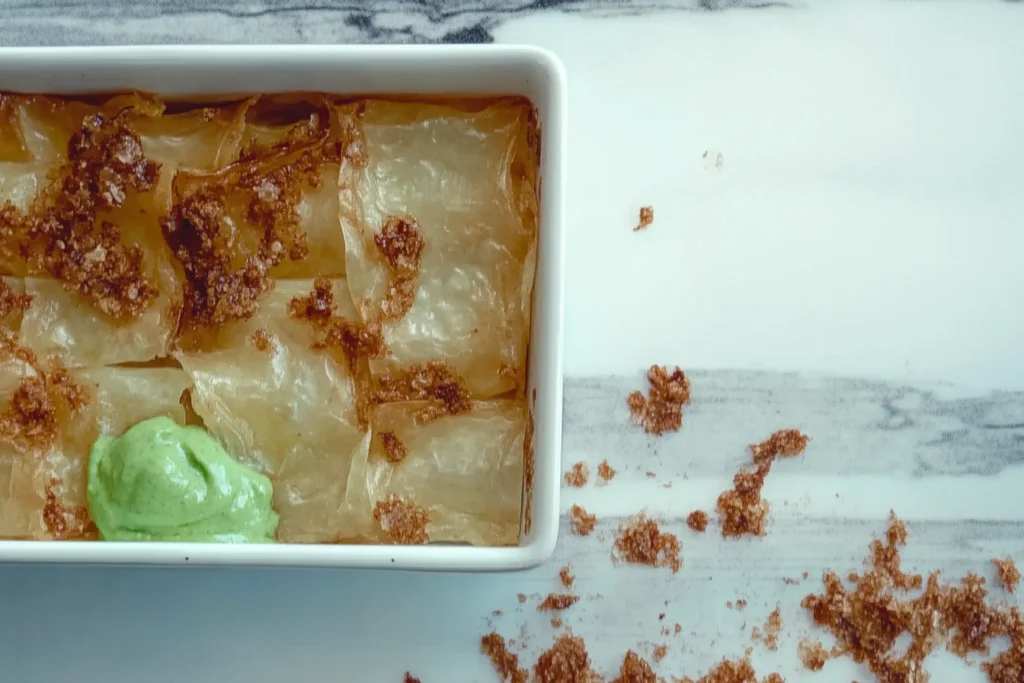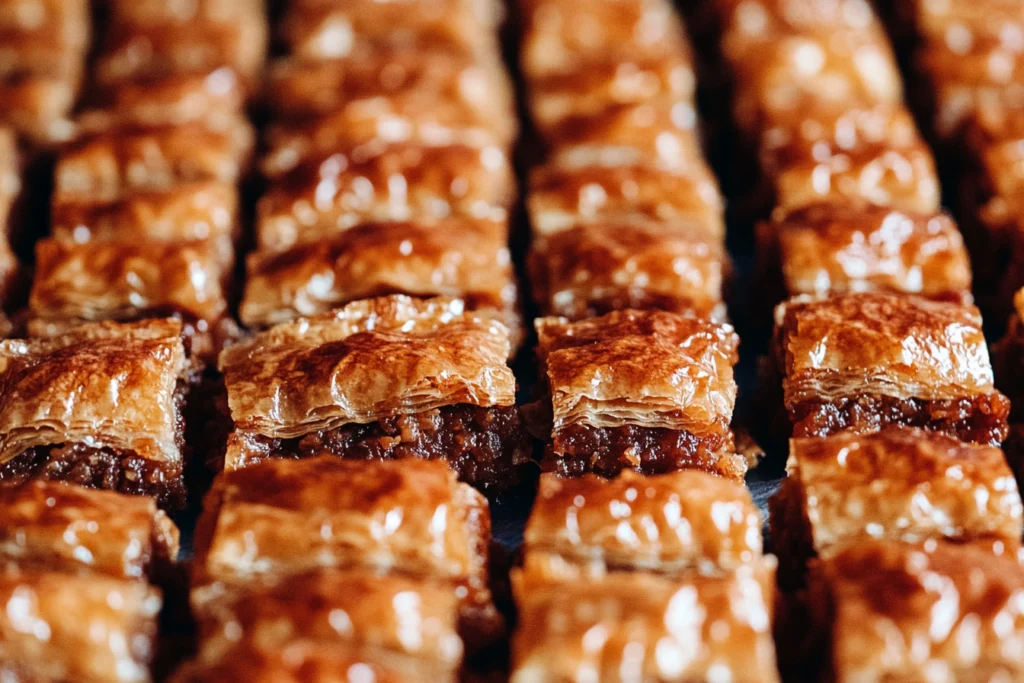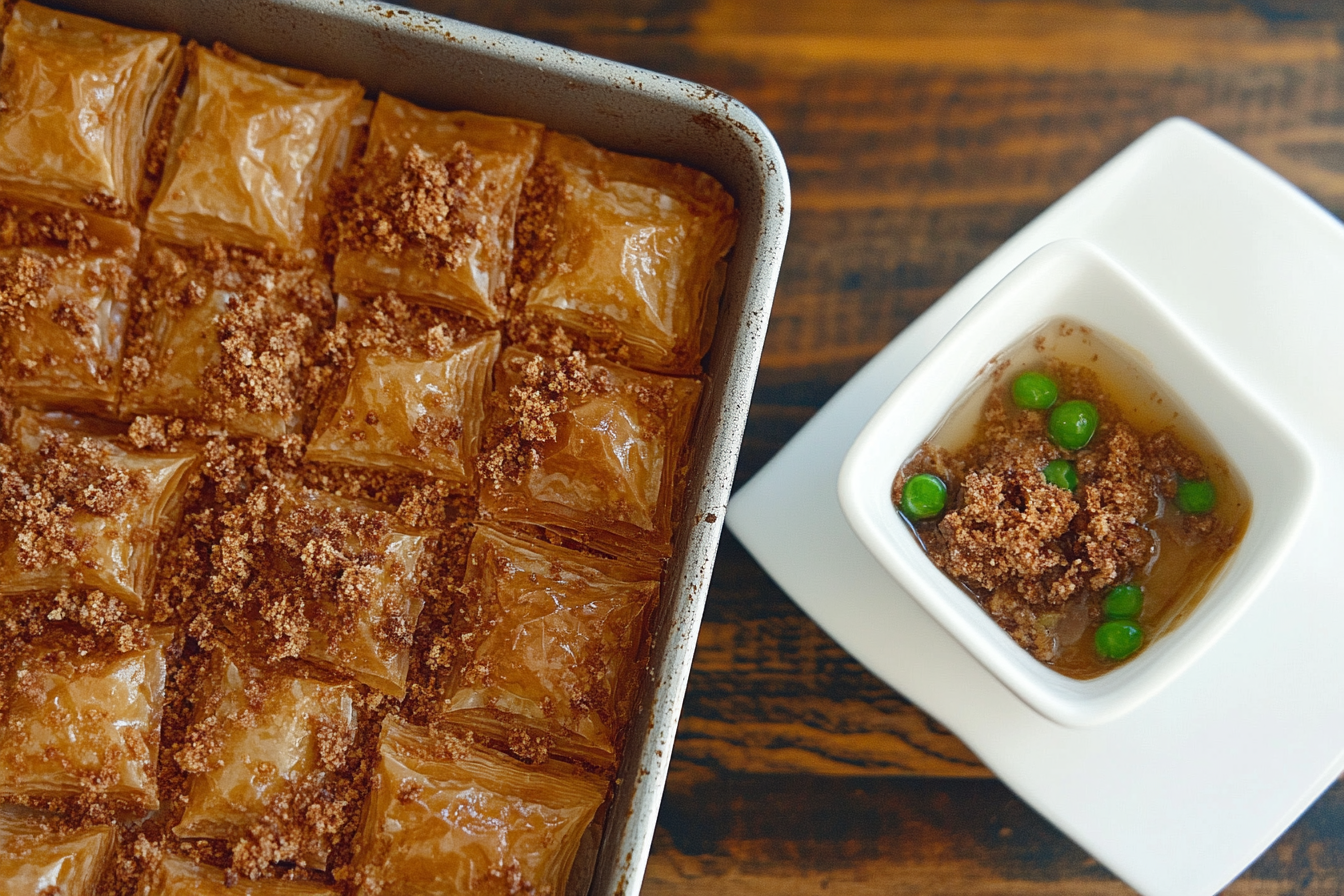Part 1: Understanding Baklava and Its Components
H1: Introduction to Baklava
Secret to Crispy Baklava – Baklava, a timeless dessert cherished across cultures, is known for its perfect balance of crunchiness and sweetness. The key to achieving a perfectly crispy baklava lies in understanding its intricate layers, precise techniques, and the science behind its crisp texture. Whether you’re a seasoned baker or a beginner, this guide will unravel the secrets to achieving the perfect crunch.
H2: Origin and Cultural Significance
Baklava’s origins are deeply rooted in the Middle East, Mediterranean, and Balkan regions. With centuries of tradition behind it, baklava has been a symbol of celebration and hospitality. In Turkish, Greek, and Arab cuisines, baklava is a centerpiece dessert, often associated with festivals and family gatherings. Its cultural significance has led to numerous regional variations, each adding unique twists to its preparation.
H3: The Essential Ingredients for Baklava
To create authentic baklava, using the finest ingredients is essential. Each component, from the phyllo dough to the syrup, plays a critical role:
- Phyllo Dough: Ultra-thin and delicate layers create the signature crunch.
- Nuts: Traditionally, walnuts, pistachios, or almonds are used for their rich, nutty flavor.
- Butter or Oil: Ensures the phyllo dough crisps up evenly.
- Syrup: Made from sugar, water, and lemon, it binds the layers and adds sweetness.
Mastering the combination of these ingredients is the foundation for success.
H4: Phyllo Dough – The Foundation of Crispy Texture
The phyllo dough is the backbone of baklava. Its paper-thin sheets allow for the flaky, crunchy layers we love. Key points to note:
- Handle phyllo dough with care, as it dries out quickly when exposed to air.
- Keep it covered with a damp cloth while working to maintain its flexibility.
- Homemade phyllo dough offers greater control over thickness but requires skill and patience.
Understanding the intricacies of phyllo dough will ensure your baklava layers are evenly crispy.
H5: Types of Nuts and Their Role in Flavors
The choice of nuts can dramatically affect the flavor and texture of baklava:
- Walnuts: Offer a mild, earthy flavor.
- Pistachios: Deliver a vibrant, slightly sweet taste.
- Almonds: Add a delicate crunch and subtle nuttiness.
Toasted nuts intensify the flavor, while finely chopping them ensures even distribution between layers.
H6: The Science Behind Syrup and Its Impact on Crispness
Syrup application is where science meets art. The syrup binds the layers and enhances the flavor, but improper timing can lead to soggy baklava:
- Use a hot syrup on cooled baklava or vice versa to maintain crispness.
- Ensure the syrup is of medium consistency to avoid oversaturation.
- Add citrus (lemon or orange) to balance sweetness and prevent crystallization.
Mastering this step is essential for achieving perfectly crispy layers.
H2: Role of Butter or Oil in Achieving Crispiness
Butter is the key to that golden, flaky finish:
- Clarified butter is preferred, as it removes milk solids that can burn during baking.
- Use a pastry brush for even application between layers.
- Avoid over-saturating the dough, as excess butter can make the baklava greasy.
Proper butter application ensures the phyllo layers bake to a perfect crunch.
H3: Common Mistakes That Lead to Soggy Baklava
Avoid these pitfalls to keep your baklava crisp:
- Applying syrup while the baklava is still hot can cause sogginess.
- Using cold butter instead of melted clarified butter can create uneven textures.
- Insufficient baking time leads to undercooked, doughy layers.
By recognizing these mistakes, you can prevent disappointment in your final results.
H4: Comparing Homemade vs. Store-Bought Phyllo Dough
While store-bought phyllo dough is convenient, homemade phyllo offers superior texture and flavor:
- Store-Bought: Ready to use but may lack the delicate, flaky texture of homemade.
- Homemade: Time-intensive but allows for customization in thickness and consistency.
Experiment with both to find what works best for your desired crispiness.
H5: How Climate and Humidity Affect Crispiness
Environmental factors can greatly impact your baklava:
- High humidity can soften the phyllo layers, making crispiness harder to achieve.
- Dry climates are more conducive to crisp textures but can cause phyllo to crack during handling.
Adapting your technique to your local climate ensures consistent results. For humid areas, consider longer baking times and cooling baklava in a dry, air-conditioned space.
The Secret to Crispy Baklava: Mastering the Art of Perfection
Part 2: Techniques for Achieving Perfectly Crispy Baklava
H1: Preparing the Phyllo Dough for Maximum Crunch
Achieving a crispy texture begins with properly preparing your phyllo dough. Whether you’re using store-bought or homemade phyllo, attention to detail is essential:
- Thaw correctly: If using frozen dough, thaw it overnight in the refrigerator, not at room temperature, to prevent stickiness.
- Handle with care: Lay the sheets flat and keep them covered with a damp cloth to avoid drying.
- Cut to fit: Trim the phyllo to the size of your baking dish to prevent uneven layers.
Proper preparation ensures your phyllo sheets are ready to deliver the desired crunch.

H2: Proper Layering Techniques for Even Texture
Layering is the heart of baklava-making and directly influences its texture:
- Use a light hand to prevent compressing the layers.
- Alternate layers of phyllo with a generous but even distribution of nuts.
- For a taller baklava, add more layers of phyllo between nut layers for a dramatic crunch.
Mastering layering creates a symphony of textures in every bite.
H3: Butter Application – Dos and Don’ts
Applying butter to phyllo dough might seem simple, but technique matters:
- Do: Use a soft-bristle pastry brush to apply melted clarified butter in thin, even strokes.
- Don’t: Pour butter directly onto the layers, as this can create uneven baking and sogginess.
- Do: Cover every inch of the phyllo to ensure uniform crispiness.
- Don’t: Use too little butter; dry layers won’t crisp up properly.
When done right, butter application ensures an evenly golden and flaky texture.
H4: Baking Temperature and Time for Optimal Results
Baking is where the magic happens, transforming raw layers into a crisp masterpiece:
- Preheat the oven to 325°F (160°C) for even heat distribution.
- Bake low and slow to allow the layers to cook through without burning.
- Look for a golden-brown color as a sign of doneness, usually after 45–60 minutes.
Proper baking seals in the crispiness while keeping the baklava’s signature softness in balance.
H5: Cooling Baklava to Preserve Crispiness
Cooling your baklava is as important as baking it:
- Allow the baklava to cool completely in the pan before adding syrup.
- Keep it uncovered during cooling to prevent steam from softening the layers.
- Ensure the baklava is at room temperature before storing to maintain its texture.
This step is key to retaining the crunch long after baking.
H6: Syrup Application – Timing and Methodology
The syrup is the soul of baklava, but its application requires precision:
- Timing: Always pour hot syrup over cooled baklava or vice versa to maintain crispness.
- Method: Use a ladle to pour syrup evenly over the entire surface, ensuring every layer absorbs the sweetness.
- Quantity: Strike a balance; too much syrup can overwhelm the crunch, while too little leaves the baklava dry.
This delicate balance between syrup and layers defines the dessert’s perfection.
H2: Experimenting with Alternative Ingredients
For a modern twist, consider alternative ingredients to add unique flavors and textures:
- Nuts: Experiment with hazelnuts, pecans, or macadamia nuts for new flavor profiles.
- Syrup: Use honey, maple syrup, or infused syrups (e.g., rose or orange blossom) for added depth.
- Spices: Add cinnamon, cardamom, or cloves to the nut mixture for warmth and complexity.
These variations can elevate your baklava while keeping its traditional essence intact.
H3: Importance of Cutting Baklava Before Baking
Cutting the baklava before baking is a crucial step for both aesthetics and functionality:
- Prevents breakage: Cutting allows each piece to crisp up evenly without cracking.
- Improves syrup absorption: Pre-cut pieces absorb syrup more effectively, enhancing flavor and texture.
- Use a sharp knife to create clean lines and traditional diamond or square shapes.
This step ensures your baklava looks professional and tastes exceptional.
H4: Achieving Crispiness in Vegan or Gluten-Free Baklava
For dietary modifications, achieving crispiness can be challenging but possible:
- Vegan: Substitute butter with coconut oil or vegan margarine.
- Gluten-Free: Use gluten-free phyllo dough or create your own with alternative flours.
- Syrup Adjustments: Stick to plant-based sweeteners like agave syrup or maple syrup for vegan versions.
These adaptations ensure everyone can enjoy the indulgence of crispy baklava.

H5: Using Specialized Kitchen Tools for Better Results
The right tools can make baklava preparation smoother and more precise:
- Pastry Brush: Essential for even butter application.
- Sharp Knife: Ensures clean cuts before baking.
- Silicone Baking Mat: Prevents sticking and promotes even heat distribution.
Investing in these tools will elevate your baklava game to a professional level.
The Secret to Crispy Baklava: Mastering the Art of Perfection
Part 3: Troubleshooting and Enhancing Baklava
H1: Identifying Common Problems in Baklava Texture
Even with the best intentions, achieving perfectly crispy baklava can sometimes go awry. Common texture issues include:
- Sogginess: Often caused by improper syrup application or excessive humidity.
- Dry Layers: Results from insufficient buttering or uneven syrup distribution.
- Burnt Edges: Caused by baking at too high a temperature or uneven heat distribution.
Recognizing these problems is the first step in troubleshooting and improving your baklava.
H2: Fixing Soggy or Overly Dry Baklava
No one wants a dessert that’s too soggy or too dry. Here’s how to fix these issues:
- For Soggy Baklava:
- Reduce the syrup quantity in future attempts.
- Place soggy baklava in a preheated oven at 300°F (150°C) for 5–10 minutes to evaporate excess moisture.
- For Dry Baklava:
- Drizzle additional warm syrup over the cooled baklava sparingly.
- Adjust the syrup recipe to include slightly more liquid or use a honey-based syrup for extra moisture.
These adjustments can salvage your baklava and guide improvements in future batches.
H3: Preserving Crispiness During Storage
Proper storage is crucial for maintaining the crisp texture of your baklava:
- Room Temperature: Store in an airtight container to keep air and moisture out.
- Avoid Refrigeration: Refrigeration can make baklava soggy by introducing condensation.
- Layer Separation: If stacking pieces, use wax paper between layers to prevent sticking.
These strategies ensure your baklava stays fresh and crispy for days.
H4: Reheating Baklava Without Losing Its Crunch
Reheating baklava requires care to avoid losing its signature crunch:
- Preheat the oven to 275°F (135°C).
- Place baklava on a baking sheet and warm for 5–7 minutes.
- Avoid microwaving, as it softens the phyllo layers.
This gentle reheating method preserves the baklava’s texture and flavor.
H5: Creative Variations for Texture and Flavor
While traditional baklava is a classic, experimenting with flavors and textures can create exciting new versions:
- Layer Additions: Include chocolate chips, dried fruit, or shredded coconut between nut layers.
- Nut Substitutions: Try exotic nuts like cashews, hazelnuts, or Brazil nuts.
- Infused Syrups: Use lavender, saffron, or vanilla-infused syrups for a gourmet twist.
These creative variations add personality to your baklava while keeping its essence intact.
H6: Regional Differences in Baklava Preparation
Baklava’s global appeal has led to fascinating regional variations:
- Turkish Baklava: Features pistachios and is often sweetened with a light sugar syrup.
- Greek Baklava: Traditionally made with walnuts and flavored with honey-based syrup.
- Middle Eastern Baklava: Incorporates cardamom, rose water, or orange blossom for aromatic complexity.
Understanding these differences can inspire you to blend traditions or perfect a specific style.
H2: Incorporating Modern Techniques for Crispy Baklava
Modern baking tools and techniques can streamline the baklava-making process:
- Convection Ovens: Ensure even heat distribution for uniformly crispy layers.
- Precision Thermometers: Help maintain the ideal syrup temperature for application.
- Food Processors: Speed up nut chopping while maintaining consistency.
Adopting these tools can improve both the quality and efficiency of your baklava-making.
H3: Tips from Professional Bakers and Chefs
Professional bakers often share invaluable insights for perfect baklava:
- Use clarified butter exclusively to avoid soggy layers.
- Let the baklava rest for at least 6 hours after adding syrup to allow flavors to meld.
- Always bake in a preheated oven for consistent results.
Following these tips can elevate your baklava to bakery-level perfection.
H4: Balancing Crispiness with Moisture for Perfection
Striking the right balance between crisp layers and moist, flavorful filling is the hallmark of a great baklava:
- Ensure the syrup is just enough to coat each layer without overwhelming it.
- Use a combination of nuts to add depth and texture to the filling.
- Avoid overpacking the layers, which can compromise crispiness.
Achieving this balance creates a baklava that’s both satisfying and indulgent.
H5: Final Thoughts: Mastering the Art of Crispy Baklava
Perfecting baklava is a journey that combines tradition, science, and creativity. From mastering the preparation of phyllo dough to understanding the role of syrup, butter, and baking techniques, each step contributes to the final product. With practice, experimentation, and attention to detail, you can create baklava that’s as crisp and delicious as those from the finest patisseries.
More FAQs
- Can I use pre-made phyllo dough for baklava? Yes, pre-made phyllo dough is convenient and widely used, but ensure it’s fresh and properly thawed.
- What’s the best nut combination for baklava? A mix of pistachios, walnuts, and almonds offers a balanced flavor and texture.
- Why does my baklava turn out soggy? Applying syrup at the wrong temperature or overusing it can lead to sogginess.
- Can I make baklava vegan? Yes, replace butter with coconut oil and use plant-based syrups like agave or maple.
- How long does baklava stay fresh? Stored in an airtight container at room temperature, it stays fresh for up to 10 days.
- Should I refrigerate baklava? No, refrigeration can make the layers soggy due to condensation.
- What’s the ideal baking temperature for baklava? Bake at 325°F (160°C) for even cooking and crispiness.
- Can I freeze baklava? Yes, freeze baked baklava in an airtight container for up to 3 months. Thaw at room temperature.
- What’s the secret to evenly cut baklava? Use a sharp knife and score the dough before baking for clean, even cuts.
- How do I infuse syrups with flavor? Simmer the syrup with spices or citrus peels, then strain before pouring over baklava.

